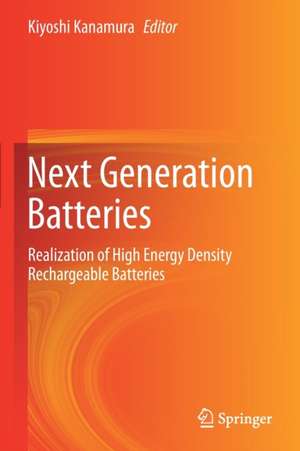Next Generation Batteries: Realization of High Energy Density Rechargeable Batteries
Editat de Kiyoshi Kanamuraen Limba Engleză Paperback – 25 mar 2022
A number of relevant aspects of all solid-state batteries with a carbon anode or Li-metal anode are discussed and described: The formation of the cathode; the interface between the cathode (anode) and electrolyte; the discharge and charge mechanisms of the Li-air battery; the electrolyte system for the Li-air battery; and cell construction.
The Li-sulfur battery involves a critical problem, namely, the dissolution of intermediates of sulfur during the discharge process. Here, new electrolyte systems for the suppression of intermediate dissolution are discussed. Li-metal batteries with liquid electrolytes also present a significant problem: the dendrite formation of lithium. New separators and electrolytes are introduced to improve the safety and rechargeability of the Li-metal anode. Mg, Al, and Zn metal anodes have been also applied to rechargeable batteries, and in this book, new metal anode batteries are introduced as the generation-after-next batteries.
This volume is a summary of ALCA-SPRING projects, which constitute the most extensive research for next-generation batteries in Japan. The work presented in this book is highly informative and useful not only for battery researchers but also for researchers in the fields of electric vehicles and energy storage.
| Toate formatele și edițiile | Preț | Express |
|---|---|---|
| Paperback (1) | 740.74 lei 43-57 zile | |
| Springer Nature Singapore – 25 mar 2022 | 740.74 lei 43-57 zile | |
| Hardback (1) | 910.58 lei 43-57 zile | |
| Springer Nature Singapore – 24 mar 2021 | 910.58 lei 43-57 zile |
Preț: 740.74 lei
Preț vechi: 903.35 lei
-18% Nou
Puncte Express: 1111
Preț estimativ în valută:
141.74€ • 148.38$ • 117.28£
141.74€ • 148.38$ • 117.28£
Carte tipărită la comandă
Livrare economică 07-21 aprilie
Preluare comenzi: 021 569.72.76
Specificații
ISBN-13: 9789813366701
ISBN-10: 9813366702
Ilustrații: XIV, 580 p. 355 illus., 235 illus. in color.
Dimensiuni: 155 x 235 mm
Greutate: 0.82 kg
Ediția:1st ed. 2021
Editura: Springer Nature Singapore
Colecția Springer
Locul publicării:Singapore, Singapore
ISBN-10: 9813366702
Ilustrații: XIV, 580 p. 355 illus., 235 illus. in color.
Dimensiuni: 155 x 235 mm
Greutate: 0.82 kg
Ediția:1st ed. 2021
Editura: Springer Nature Singapore
Colecția Springer
Locul publicării:Singapore, Singapore
Cuprins
1. General Introduction.- 2. Batteries for Electric Vehicle and Energy Storage.- 3. Li Metal Battery.- 4. All Solid State Battery.- 5. Li-Sulfur Battery.- 6. Li-Air Battery.- 7. Metal (Mg, Al, Zn) Anode Batteries.- 8. Summary.
Notă biografică
Kiyoshi Kanamura received Ph.D. from Kyoto University in 1987. He is a full Professor at Tokyo Metropolitan University. His research interests are electrochemistry, surface science, materials science, colloid science, electrochemical energy conversion systems and related devices.
Textul de pe ultima copertă
In this book, the development of next-generation batteries is introduced. Included are reports of investigations to realize high energy density batteries: Li-air, Li-sulfur, and all solid-state and metal anode (Mg, Al, Zn) batteries. Sulfide and oxide solid electrolytes are also reviewed.
A number of relevant aspects of all solid-state batteries with a carbon anode or Li-metal anode are discussed and described: The formation of the cathode; the interface between the cathode (anode) and electrolyte; the discharge and charge mechanisms of the Li-air battery; the electrolyte system for the Li-air battery; and cell construction.
The Li-sulfur battery involves a critical problem, namely, the dissolution of intermediates of sulfur during the discharge process. Here, new electrolyte systems for the suppression of intermediate dissolution are discussed. Li-metal batteries with liquid electrolytes also present a significant problem: the dendrite formation of lithium. New separators and electrolytes are introduced to improve the safety and rechargeability of the Li-metal anode. Mg, Al, and Zn metal anodes have been also applied to rechargeable batteries, and in this book, new metal anode batteries are introduced as the generation-after-next batteries.
This volume is a summary of ALCA-SPRING projects, which constitute the most extensive research for next-generation batteries in Japan. The work presented in this book is highly informative and useful not only for battery researchers but also for researchers in the fields of electric vehicles and energy storage.
Caracteristici
Reports on the developments and investigations in next-generation batteries Enables readers to understand the current status of studies, difficulties in science, and challenging technological issues of next-generation batteries Provides a view of the future of next-generation batteries
